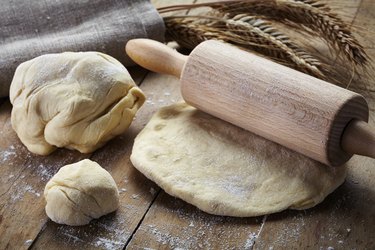
A heavy, well-made rolling pin seasoned with the imperceptible traces of the thousands of doughs it rolled before gives a baker a feeling of esteem, a type of nostalgia, if you will, that affirms his experience and dedication in the baking and pastry arts. It also affirms, however, that the tiny pores and grooves from the wood's grain have gummed up with a mixture of oil and old flour that causes it to stick to fresh, moist dough. You have to create a nonstick surface on the rolling pin using flour and clean it regularly to prevent sticking.
Wax Paper
Video of the Day
Step 1
Place a large sheet of wax paper on the work surface.
Video of the Day
Step 2
Lay the dough in the center of the wax paper. Place another sheet of wax paper over the dough.
Step 3
Flatten the dough with the rolling pin.
Flour
Step 1
Dust the work surface liberally with flour.
Step 2
Sprinkle flour over the rolling pin lightly then roll the rolling pin over the flour you sprinkled on the work surface to cover it on all sides. Rub your palm over the pin to work the flour into it.
Step 3
Flatten the dough with the rolling pin. Add more flour to the rolling pin when needed to prevent sticking.
Tip
Weekly cleaning with dish soap and warm water will help prevent dough from sticking to wooden rolling pins.
Cover wooden rolling pins with a nonstick rolling pin cover to prevent the dough from sticking and to protect the surface from damage.